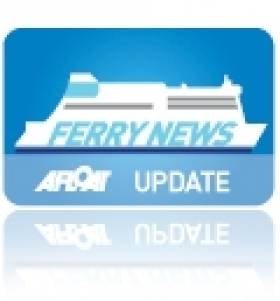Displaying items by tag: Stena Voyager
New Belfast-Cairnryan Route Celebrates First Sailings
#FERRY NEWS - Demotix reports that the first ferries have sailed to Northern Ireland from the new £200m Stena Line port facility at Cairnryan in western Scotland.
The company's final sailings from Stranraer took place at the weekend before the official relocation to the new port, which lies closer to the mouth of Loch Ryan and the North Channel.
As previously reported on Afloat.ie, the Stena Superfast VII is serving the new route following the mothballing of the Stena Voyager service.
The ferry and her sister ship Stena Superfast VIII are on charter from Scandinavian ferry operator Tallink, and are the largest ferries ever to service the North Channel route.
Images of the new Belfast-Cairnryan Stena Line crossing are available HERE.
Irish Sea Cross Channel Fast-Ferry Services On Declining Trend
The third service between Belfast-Stranraer is in the hands of rivals Stena Line which maintain the HSS Stena Voyager (1996/19,638 grt) on sailings but only to around mid-November. She will be replaced by conventional sister-ships which will be introduced on the North Channel's newest port when services switch from Stranraer to a new terminal close to Cairnryan.
Finally the fourth fast-ferry is Irish Ferries marketed 'Dublin Swift' service which runs on the Dublin-Holyhead route served by Jonathan Swift (1999/5,989 grt). The craft built by Austal in Fremantle, operates alongside the conventional cruise-ferry Ulysses.
Stena Line's decision to terminate HSS Stena Explorer sailings between Dun Laoghaire-Holyhead this day last week follows fast-ferry Stena Lynx III's end-of-season Rosslare-Fishguard sailings earlier this month.
From next year, Dun Laoghaire-Holyhead sailings are to be seasonal-only and according to Stena Line they hope to resume fast-ferry sailings in April or May though no exact date has been set. Unlike the central corridor route which was entirely dependent on HSS operations, the Rosslare-Fishguard route remains operating year-round with the conventional ferry Stena Europe.
As a result of the discontinued fast-ferries, the HSS Stena Explorer is now spending a lay-up period in the Welsh port for the winter. The smaller Stena Lynx III is also 'wintering' but in on the opposite side of the Irish Sea in Dun Laoghaire, where the vessel has done so in previous years.
The lay-up of both fast-ferries in Dun Laoghaire and Holyhead is ironic considering that neither ports' are connected by the very craft that used to share sailing rosters in recent years. In addition the wintering of these catamaran craft is the first time that this has occurred since the pioneering Stena Sea Lynx fast-ferry launched such sailings in 1993.
This first 'Lynx' provided seasonal sailings on the route with conventional car-ferry Stena Hibernia, the former St. Columba, custom-built in 1977 for Sealink /British Rail. She was given a second name under Stena ownership, the Stena Adventurer and remained on the 57 nautical-mile route until replaced in 1996 by the year-round operated HSS Stena Explorer.
Apart from cross-channel fast-ferry services, the Isle of Man is served by the Isle of Man Steam Packet Co. Ltd's routes linking the islands capital Douglas with Belfast, Dublin, Heysham and Liverpool (Birkenhead) in the winter. These routes include seasonal services which are operated by a combination of conventional tonnage using Ben-My-Chree and fast-ferry Manannan (1998/5,089grt), a former US Navy vessel, to read more click HERE. For sailing schedules, vessel type deployed on route and for fares click HERE.
- Dublin Port
- Irish Ferries
- Dun Laoghaire
- Stena Europe
- Holyhead
- P&O Ferries
- Belfast Harbour
- Stena Line
- Larne
- Ports and Shipping News
- Ulysses
- P&O (Irish Sea)
- Cairnryan
- Ferry news
- Stena Explorer
- Stena Express
- FastFerries
- Cruiseferry
- Manannan
- Isle of Man Steam Packet Co.
- Stena Voyager
- Belast Port
- Isle of Man ferry services
- P&O Express
- Irish Sea fastferries
- Stena 'Lynx'
- BenMyChree
- Dublin Swift
- Stena Sea Lynx
Bon Voyage to Stena Voyager
The Stena Voyager high-speed ferry will make its final crossing between Belfast and Stranraer in mid-November.
BBC News cites the high cost of running the service, as well as its limited freight capacity, as reasons for the mothballing of the Stena HSS (High Speed Service).
The world's biggest high-speed ferry was a revelation when it was launched in 1996. The catamaran could reach speeds of up to 40 knots powered by enormous gas turbine engines.
But the rising cost of oil prompted a reduction in the ferry's cruising speed to save costs, making room for competition from conventional ferry routes with larger freight capacities.
The Voyager's fate was sealed when Stena Line announced plans to move its Stranraer port to a new location that will shave 20 minutes off the crossing for the two new but standard ferries that will replace it.
As previously reported on Afloat.ie, the Stena HSS between Dun Laoghaire and Holyhead will also be suspended from later this month, though it is planned to resume service in 2012 for the summer season.































































